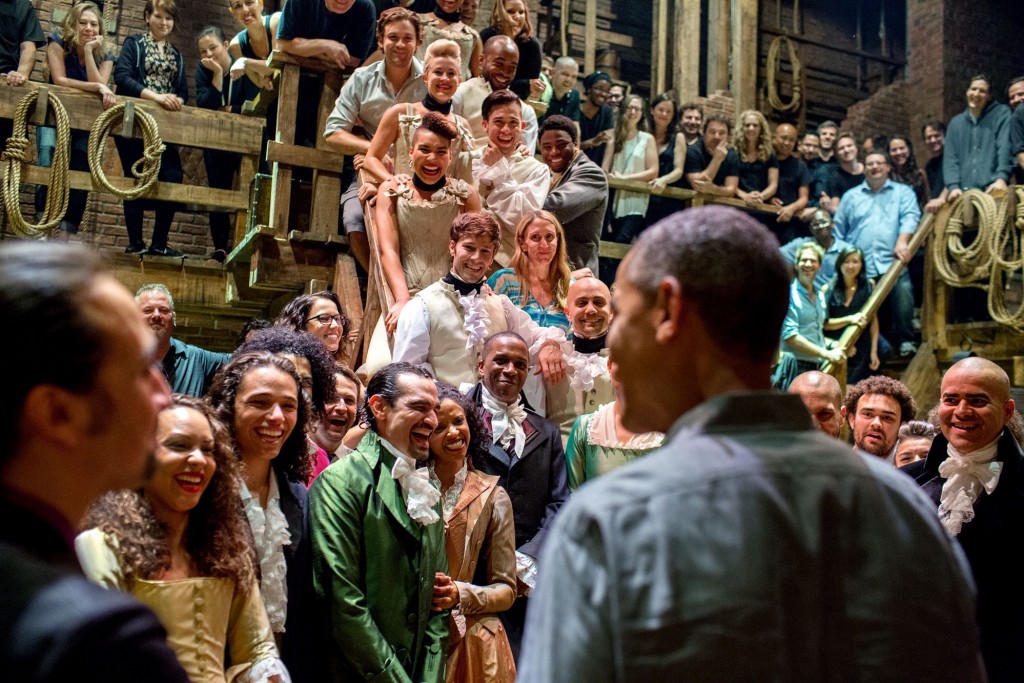
Photo Courtesy of Pete Souza, Wikipedia
The Broadway musical “Hamilton” is on the fast track to musical theater history. It won the Grammy for Best Musical Theater Album this year, launched at No. 12 on the Billboard 200 — the highest recorded debut for a cast recording, according to Billboard — and is set to dominate the Tony Awards in June. Written by Lin-Manuel Miranda, the show relies heavily on rap music to tell the story of Alexander Hamilton, following the American forefather from his college days to his death.
One of the truly unique aspects of “Hamilton” is its choice of casting. Nearly every lead character is played by a person of color, despite the fact that they are all depicting white men and women. Miranda, who stars as Alexander Hamilton, is of Puerto Rican descent. Leslie Odom, Jr., who plays Aaron Burr, is black. Phillipa Soo, who plays Hamilton’s wife Elizabeth Schuyler, is Chinese-American. In fact, the only principle character played by a white actor is King George, currently portrayed by Jonathan Groff.
“Hamilton” was initially lauded for its diverse cast, but recently was criticized when it released an open casting call that specifically asked for non-white actors to audition for the show. The Actors’ Equity Association union, which typically looks over casting calls, got involved, saying the language of the notice did not comply with their rules, according to the New York Times.
“Our audition rules are created to provide the broadest access possible for our members to be seen for roles,” the Actors’ Equity Association said.
It’s common practice for casting calls to indicate a preferred race, gender and age, but auditions, the New York Times reports, should be open to anyone, as per the union’s rules. The producers of “Hamilton” agreed to adjust the language of the casting call, which currently says, “Seeking men and women, ages 20s to 30s, for the non-white characters as written and conceived for the currently running Broadway production and upcoming Tours of HAMILTON,” and goes on to say, “Performers of all ethnic and racial backgrounds are encouraged to attend.” The change is minimal, and holds true to the show’s dedication to casting non-white actors.
The show’s lead producer, Jeffrey Seller, released a statement saying, “‘Hamilton’ depicts the birth of our nation in a singular way. We will continue to cast the show with the same multicultural diversity that we have employed thus far.”
The issue, at least with the Actors’ Equity Association, boils down to semantics, but the very fact that “Hamilton” received pushback at all is indicative of a larger problem. The casting call wasn’t under fire because it wasn’t inclusive enough – it was under fire because white people felt left out.
There are a couple of different ways to digest what’s wrong with the amount of criticism “Hamilton” received for its casting call. The most obvious is that people cried foul about something that provided opportunities for actors of color in a predominantly white-washed institution. There is no want for roles on Broadway for white actors. There are 36 shows that are currently, or soon to be, running on Broadway; of these, only eight feature lead characters played by a person of color, one being “Hamilton.” Very rarely do shows employ colorblind casting. “Les Misérables” is one example of a musical that has looked past race (the show is set in 1800s Paris, so all of its main characters would, historically, be white) and hired actors based on talent alone. This, unfortunately, is not the standard.
Broadway also has a tendency to regurgitate old shows, which, again, usually feature white characters. Revivals of old hit shows are almost a guaranteed financial success, so audiences typically see a number of revivals cycled through each season. Therefore, there is a lack of new material on Broadway with new roles intended for actors of color. That said, even if a new show makes its way to Broadway, there’s still a large chance it will rest on old tropes: a mostly white cast with a few token black characters. Auditions may have to be open to anyone, but when directors are looking to cast yet another iteration of “Guys and Dolls,” you see the problem. “Hamilton” subverted this norm, and was met with outrage.
What’s more, the casting for “Hamilton” is deliberate. It’s not like “Les Misérables,” which casts in spite of race; “Hamilton” casts because of race. Miranda and other members of the cast have spoken time and time again about the importance of casting people of color in the lead roles of “Hamilton.”
Renée Elise Goldsberry, who plays Hamilton’s sister-in-law, Angelica Schuyler, said to Time Magazine, “Hamilton is a story about America, and the most beautiful thing about it is … it’s told by such a diverse cast with such diverse styles of music. We have the opportunity to reclaim a history that some of us don’t necessarily think is our own.”
“Hamilton,” on its most basic level, is the story of a white man, but it deals with issues that have plagued America since its founding. Hamilton is mocked for being an immigrant by his contemporaries: Thomas Jefferson and James Madison. Every death in the musical is a result of gun violence (Hamilton was shot and killed in a duel with Aaron Burr). And it’s no mistake that the lead characters, who are, again, all played by people of color, are fighting against the oppression imposed on them by the only white character, King George.
“Hamilton” takes a story that every American child reads in their history books and brings it to life, humanizing it and making it relevant to a modern, diverse audience. It allows every person of every race to relate to the American story.
It’s absurd that one of the most diverse casts on Broadway is being criticized for a lack of inclusiveness. I think this is less a case of discrimination on behalf of “Hamilton” and more a case of whites wanting to appropriate what is good and what is not theirs, which history has seen time and time again. While I’m frustrated by this confict, I’m happy to see that the minds behind “Hamilton” are not folding under the pressure of wounded white privilege.
rking2@ramapo.edu





